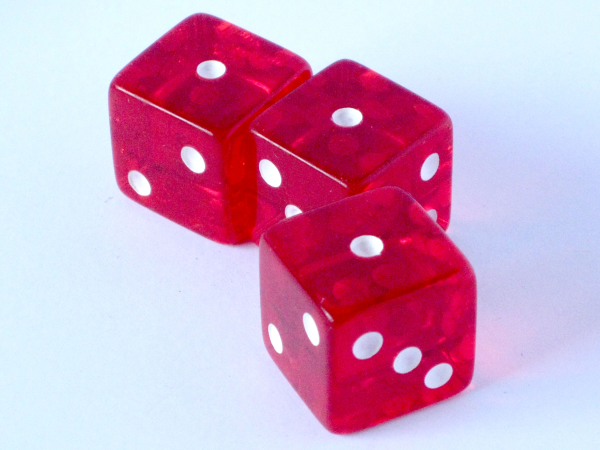Using dominoes for ability score generation works a lot like the previous rules. For this, since you are emulating 3d6, you can either use two sets of double 9s or just one set. If you use one set of double 9s, a friendly warning. It does have a different probability spread than classic 3d6. The probability percentages are below, using the value of 55 dominoes for a set of double 9s.
| Value | Probability Fraction | Prob. % |
| 0 | 1/55 | 1.8% |
| 1 | 1/55 | 1.8% |
| 2 | 2/55 | 3.6% |
| 3 | 2/55 | 3.6% |
| 4 | 3/55 | 5.4% |
| 5 | 3/55 | 5.4% |
| 6 | 4/55 | 7.2% |
| 7 | 4/55 | 7.2% |
| 8 | 5/55 | 9.0% |
| 9 | 5/55 | 9.0% |
| 10 | 5/55 | 9.0% |
| 11 | 4/55 | 7.2% |
| 12 | 4/55 | 7.2% |
| 13 | 3/55 | 5.4% |
| 14 | 3/55 | 5.4% |
| 15 | 2/55 | 3.6% |
| 16 | 2/55 | 3.6% |
| 17 | 1/55 | 1.8% |
| 18 | 1/55 | 1.8% |
As you see, the average runs to about 8-10, or 9. This could mean that values will end up a bit lower than what you would find on simply rolling 3d6. With this method, the bell curve is shallower. So while the average stat dropped will be 1.5 lower than on 3d6, you have nearly 4x the chance of rolling an 18 (and conversely, a 1) than you do rolling 3d6. So keep this in mind. This method will produce average scores with a higher deviation to the extremes when using a single set of double 9s. Now remember that we'll have to remove the 0, 1, and 2 values to make the values right, so many of these percentages will increase. That means that in reality, we will be drawing from a boneyard of 51 dominoes. So drawing a 3 will actually be a 5.8% chance, compared to .46% on 3d6. That's a bit rough. So how do we balance out these probability issues?
Usage #2: Generating Ability Scores With 1 Set of Double 9s
For this method, put your double 9 set into a bag, removing the 0, 1, and 2 values. Mix everything up, then draw seven bones. Add the two numbers on each bone to reveal your stat. Write them down.
Now, try and match up dominoes with like numbers. So if you draw a 4-3 and a 3-9, you can connect then via the 3. A bone can only connect to two other tiles (one for each number), unless it's a spinner, in which it can connect to four. Count how many tiles are connected. This is the value you can add to any of your stats. You can even split them between stats. If you can connect two groups of dominoes, then total the tiles and add them. Once you assign your number to your stats, drop the lowest and assign them how you desire.
Example: Mariah is making a Psychic for her Stars Without Number game. She draws seven bones, getting [4-3, 3-6, 5-7, 8-3, 4-2, 7-1, & 4-0], for values of [7, 9, 12, 11, 6, 8, 4]. Some rough scores. Mariah begins connecting the dominoes, able to connect the 2-4, 4-3, and 3-8 together as well as the 5-7 and 7-1 in a separate group. This gives a total of 5 tiles that are connected. Now she can split the 5 to any of her stats, or simply add it all to one. Mariah decides to add 4 to the 12 and 1 to the 11, then drops the 4. Her new stats are 7, 9, 16, 12, 6, and 8. A little better.
At the GM's option, a player can trade out a stat and draw a new one from the boneyard. Play can choose whichever one they want. This can help alleviate the more wonkiness of the stat distribution of double 9s.
So that's ability score generation for dominoes. While it's a bit more complicated than just rolling 3d6, there is a sort of fun moving around the dominoes and connecting them together. If you find fun in tactile stuff, this is definitely great. I find it takes the same amount of time as rolling 3d6. And, you can simply lay out all the values and write them down in one go, rather than rolling 3d6 six times and writing the values after each roll. Let me know what you think below.











.png/revision/latest?cb=20131007141858)